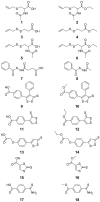Comparative Study of Different H2S Donors as Vasodilators and Attenuators of Superoxide-Induced Endothelial Damage
- PMID: 36829903
- PMCID: PMC9951978
- DOI: 10.3390/antiox12020344
Comparative Study of Different H2S Donors as Vasodilators and Attenuators of Superoxide-Induced Endothelial Damage
Abstract
In the last years, research proofs have confirmed that hydrogen sulfide (H2S) plays an important role in various physio-pathological processes, such as oxidation, inflammation, neurophysiology, and cardiovascular protection; in particular, the protective effects of H2S in cardiovascular diseases were demonstrated. The interest in H2S-donating molecules as tools for biological and pharmacological studies has grown, together with the understanding of H2S importance. Here we performed a comparative study of a series of H2S donor molecules with different chemical scaffolds and H2S release mechanisms. The compounds were tested in human serum for their stability and ability to generate H2S. Their vasorelaxant properties were studied on rat aorta strips, and the capacity of the selected compounds to protect NO-dependent endothelium reactivity in an acute oxidative stress model was tested. H2S donors showed different H2S-releasing kinetic and produced amounts and vasodilating profiles; in particular, compound 6 was able to attenuate the dysfunction of relaxation induced by pyrogallol exposure, showing endothelial protective effects. These results may represent a useful basis for the rational development of promising H2S-releasing agents also conjugated with other pharmacophores.
Keywords: hydrogen sulfide; hydrogen sulfide-donors; oxidative stress; pyrogallol; superoxide anion; vascular endothelium; vasodilation.
Conflict of interest statement
The authors declare no conflict of interest.
Figures



Similar articles
-
Trends in H2S-Donors Chemistry and Their Effects in Cardiovascular Diseases.Antioxidants (Basel). 2021 Mar 11;10(3):429. doi: 10.3390/antiox10030429. Antioxidants (Basel). 2021. PMID: 33799669 Free PMC article. Review.
-
The Effects of Novel Triazolopyrimidine Derivatives on H2S Production in Lung and Vascular Tonus in Aorta.Pharmacology. 2023;108(6):530-539. doi: 10.1159/000533419. Epub 2023 Sep 11. Pharmacology. 2023. PMID: 37696255
-
Effects of fast versus slow-releasing hydrogen sulfide donors in hypertension in pregnancy and fetoplacental growth restriction.Naunyn Schmiedebergs Arch Pharmacol. 2019 Dec;392(12):1561-1568. doi: 10.1007/s00210-019-01697-0. Epub 2019 Jul 30. Naunyn Schmiedebergs Arch Pharmacol. 2019. PMID: 31363805
-
Vasorelaxant Effect of Novel Nitric Oxide-Hydrogen Sulfide Donor Chalcone in Isolated Rat Aorta: Involvement of cGMP Mediated sGC and Potassium Channel Activation.Curr Mol Pharmacol. 2020;13(2):126-136. doi: 10.2174/1874467212666191025092346. Curr Mol Pharmacol. 2020. PMID: 31654520
-
Biological Effects of Morpholin-4-Ium 4 Methoxyphenyl (Morpholino) Phosphinodithioate and Other Phosphorothioate-Based Hydrogen Sulfide Donors.Antioxid Redox Signal. 2020 Jan 10;32(2):145-158. doi: 10.1089/ars.2019.7896. Antioxid Redox Signal. 2020. PMID: 31642346 Review.
Cited by
-
Use of Enzymatically Activated Carbon Monoxide Donors for Sensitizing Drug-Resistant Tumor Cells.Int J Mol Sci. 2023 Jul 9;24(14):11258. doi: 10.3390/ijms241411258. Int J Mol Sci. 2023. PMID: 37511019 Free PMC article.
-
Galactose: A Versatile Vector Unveiling the Potentials in Drug Delivery, Diagnostics, and Theranostics.Pharmaceuticals (Basel). 2024 Feb 27;17(3):308. doi: 10.3390/ph17030308. Pharmaceuticals (Basel). 2024. PMID: 38543094 Free PMC article. Review.
-
Mechanistic Intimate Insights into the Role of Hydrogen Sulfide in Alzheimer's Disease: A Recent Systematic Review.Int J Mol Sci. 2023 Oct 23;24(20):15481. doi: 10.3390/ijms242015481. Int J Mol Sci. 2023. PMID: 37895161 Free PMC article. Review.
-
Hydrogen Sulfide: An Emerging Regulator of Oxidative Stress and Cellular Homeostasis-A Comprehensive One-Year Review.Antioxidants (Basel). 2023 Sep 7;12(9):1737. doi: 10.3390/antiox12091737. Antioxidants (Basel). 2023. PMID: 37760041 Free PMC article. Review.

